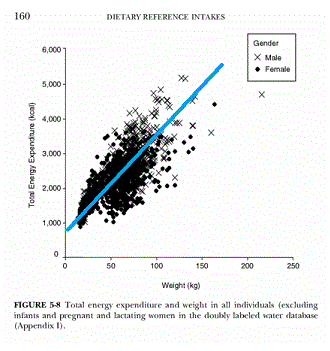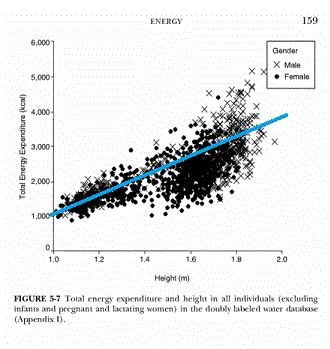How Many Calories to Lose Weight
For the number of calories in food to be relevant, one first needs to know about how many calories to lose weight. There are many good weight loss calculators on the Internet and I am going to give you one below that is based on the Revised Harris-Benedict Formula (Yes there is one formula for Women and another formula for Men), but before you get started too fast please read about some of the problems that may occur on you way to losing weight. I may have promised you a simple way to lose weight, but weight loss is never easy.First warning. All calorie calculators and weight loss charts are based on averages. You are not an average; you are an individual. Here are two graphs that demonstrate how data is gathered in order to estimate calorie needs. The first picture shows how heavier people require more calories, and the second chart shows how taller people need more calories.

 As you look at these two
charts to the left, ask yourself which one on the dots am I if you are
a female and which one of the X's are you if you are a male.
If you keep weighting yourself, with time you will know
better than anyone how many calories you will need to lose weight.
As you look at these two
charts to the left, ask yourself which one on the dots am I if you are
a female and which one of the X's are you if you are a male.
If you keep weighting yourself, with time you will know
better than anyone how many calories you will need to lose weight.Keep these two charts in mind as you try to find out how many calories you need to lose weight. Also be sure to record your weight daily or at a minimum once a week so that you can see whether or not you are losing weight. If you are not losing weight, you may need to reduce the number of calories that you consume, or get more exercise. A good weight loss chart to plot your weight is a great tool to help lose weight. If you join a weight loss program, the first thing they do is to start such a chart.
Before going to the easy calculator, first look at the chart below. Most of the government websites give you this kind of information that is good for most average people who are trying to lose weight. The first chart put out by the National Institute of Health (nih) gives the suggestion of how many calories you should eat if you want to maintain your weight:
Chart of How Many Calories to Maintain Weight
| Sedentary | Moderately Active | Active | ||
| Child | 2-3 | 1,000 | 1,000 - 1,400 | 1,000 - 1,400 |
| Female | 4-8 | 1,200 | 1,400 - 1,600 | 1,400 - 1,800 |
| Female | 9-13 | 1,600 | 1,600 - 2,000 | 1,800 - 2,000 |
| Female | 14-18 | 1,800 | 2,000 | 2,400 |
| Female | 19-30 | 2,000 | 2,000 - 2,200 | 2,400 |
| Female | 31-50 | 1,800 | 2,000 | 2,200 |
| Female | 51+ | 1,600 | 1,800 | 2,000 - 2,200 |
| Male | 8-Apr | 1,400 | 1,400 - 1,600 | 1,600 - 2,000 |
| Male | 13-Sep | 1,800 | 1,800 - 2,200 | 2,000 - 2,600 |
| Male | 14-18 | 2,200 | 2,400 - 2,800 | 2,800 - 3,200 |
| Male | 19-30 | 2,400 | 2,600 - 2,800 | 3,000 |
| Male | 31-50 | 2,200 | 2,400 - 2,600 | 2,800 - 3,000 |
| Male | 51+ | 2,000 | 2,200 - 2,400 | 2,400 - 2,800 |
I know what you are saying. This chart only gives the number of calories to maintain your weight. The basic guideline is that a pound of fat has 3500 calories, so if you eat 500 calories a day less (3500/7) then you will lose about a pound a week. For children I would suggest that you just try to keep their calories at maintenance levels so that they have a chance to outgrow their weight. For Children also make sure that they have enough nutrients including fat. Their brain cells will short circuit with out the insulation of fat. For Adults I have I have reduced the numbers by 500 calories to give you an idea of how many calories you should consume to lose one pound a week.
Chart of How Many Calories to Lose Weight
| Sedentary | Moderately Active | Active | ||
| Female | 14-18 | 1,300 | 1,500 | 1,900 |
| Female | 19-30 | 1,500 | 1,500 - 1,700 | 1,900 |
| Female | 31-50 | 1,300 | 1,500 | 1,700 |
| Female | 51+ | 1,100 | 1,300 | 1,500 - 1,700 |
| Male | 14-18 | 1,700 | 1,900 - 2,300 | 2,300 - 2,700 |
| Male | 19-30 | 1,900 | 2,100 - 2,300 | 2,500 |
| Male | 31-50 | 1,700 | 1,900 - 2,100 | 2,300 - 2,500 |
| Male | 51+ | 1,500 | 1,700 - 1,900 | 1,900 - 2,300 |
BMR Calculators for Men and Women
If you are really heavy or really tall, you may prefer to use a BMR calculator that takes into consideration your size and age.In 1918 Harris and Benedict came up with a way to determine the BMR or both men and women; then in 1984 Rosa and Benedict came up with a more accurate equation. Because there are separate equations for both men and women I have pages for:
BMR Calculator for Women
BMR Calculator for Men